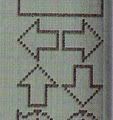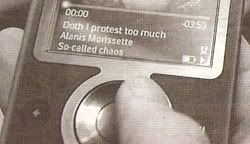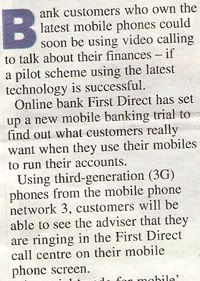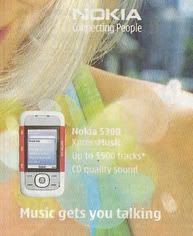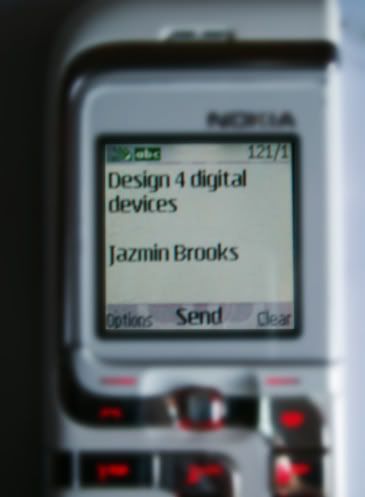Thursday 30 November 2006
Mobile Shopping
Memory-Stick Single
It also talks about the history of music platforms a bit, apparently Jamiroquai released his greatest hits album to mobile users first.
There's definitely a little world evolving there.
Read the article here.
Stop Stealing Sheep... and invent a tiny font.
The Mini 7 series he talks about is available here, but unfortunately costs money. I found some other fonts on dafont.com - they have the Nokia font, and if you search for mini it comes up with some interesting fonts that may be of use.
Spiekermann, E & Ginger, E.M. (2003). Stop Stealing Sheep (2nd Edition). California: Peachpit Press.
Hmm, something to combat my idea...
Time is not the only event that can be transferred into graphical approach. For example network reception level: good signal – sky is blue, no signal or weak one – sky is covered with clouds. At first you don’t pay much attention to this small feature, but after a month you will look on the sky instead of standard bar, information can be acquired instantly."
I love their ideas and what they've done with it. Though it sort of covers what I was talking about with time and location in regards to my idea - which is a little annoying. But it still leaves room for me to develop on the other areas.
There's definitely some innovative thinking in there, worth a look. And I want the phone.
The "Zune".
As far as I'm aware the I-Pod doesn't have wireless capabilities yet - I did find this article discussing the possibilities that would open up (and also they raise the question of who wants to watch a movie on a 3 inch screen? But I suppose the way sharing media is changing, that's no longer such a huge issue) - I guess Microsoft beat them to it?
Anyway, this article talks about what the Zune can do, with all it's wireless amazingness, and what Apple say to that. I personally think it's a bit late for Microsoft to launch a competitor in a hope to overtake the I-Pod, but I guess we shall see.
ETA: I just found this - the Zune's already second place in the US MP3 market - but still has a long way to go to catch up to I-Pod.
Another Metro, November 13th.
Remediation
Bolter, JD and Grusin, R. (1999). Remediation. London: The MIT Press.
I read Bolter and Grusin's Remediation a few weeks ago, and whilst the book in general was a nice solid foundation for thought, I didn't tag a lot of the pages as directly useful for this project. I did however tag this extract, I think it links into what Richard was saying in his lecture about different media coming together, the way television's changing, and the whole idea of convergence, market niches and what not. It's not very long, but worth thinking about.
Video Banking - Immediacy
Another article from the Metro - I can't afford a real paper. November 13th Edition.
This reminds me of something the guys who wrote Remediation talk about - the need for immediacy. It talks about the fact that they are trialling it based on the way their customers want to bank. The technology available now I guess for them to be able to do this - and it's certainly a novel idea. But like the article says - the customers would need to have the technology, and the means to fund having a 3G enabled phone... I guess we'll see how it goes.
Additional articles can be found here and here. The official site for First Direct's mobile trials is here.
A link to an article about HSBC allowing customers to access their accounts via text messaging is here.
Wednesday 29 November 2006
Nokia Exhibits - Distributed Media
Nokia - Connect to Art
"Connect to Art is a collection of modern art for your mobile Nokia phone. This new media of art is innovative and inspiring. It's always with you, you can create a collection of your own!"
I really like this idea, and I think it ties in nicely with my idea - sharing art, it seems like such a good idea. I'd download something if only I could remember my model number. Haha.
I'm guessing this will become a more popular way of getting things out there - people are already sharing all sorts of things virally, mobile to mobile etc. Nothing's limited to sending a forward email anymore and phones/devices are becoming more for entertainment and a talking point.
Device Convergence - Reach for the Sky
Click the image to see the full advert.
This first one really shows the convergence between devices - music and the phone. It plays on the idea that the music you listen to could influence who you call, will "get you talking", despite advertising it as a music player.
This second advert is for the service Sky now offer where you can text your Sky+ box to record things should you forget to set it. An interesting and innovative (but unecessary?) way to remotely control a household appliance. I guess there's plenty of other things that could happen with this - particulary with that "Smart" fridge thing - you could check it's contents whilst you're at the supermarket...
The Gadget Show
Why have I got a Bluetooth?
Interesting little article on the whys and wherefores of Bluetooth and some talk about it's uses - some uses weirder than others.
An article on different mobile phones written in Marchtime.
This talks about the phones that are out now, and what they thought of them. They seem to love the Motorola, I don't know why - I never was a fan of their interface or their phone design. Probably down to when I did have one it was quite different to what I was used to using.
I love random trivia.
That's probably the best thing I've heard all day.
So what's the big idea?
--
I don’t think mobile devices are all that nice to look at anymore. The evolution of the phone has been a peculiar one, moving from the trendy, customisable, “everyone must have” Nokias, to smaller phones, and now to colour screens, back to larger devices – of which the case and various things are not so easy to customise – in fact, I think that industry may have disappeared altogether. I no longer see the stalls for the phone shells at markets and things. The choice given is a colour in a specific range or none at all. And once you have it you’re stuck with it.
Nokia's phone history - has a nice little flash demo of their models over the years.
I know this mostly links to product design, but I think it is interesting the way people are happier now to just settle for what they’re given, and customise their phones in other ways. What with mobile cameras, customising the actual interface has become a lot easier. I remember the days when you had to pay £3 just to get a different screensaver on the old Nokias – I have no idea what other companies offered, but from what I remember the Nokia was the most customisable in that sense too.
This is something I’d like to pick up on, looking at the interface and the way people interact with their phones, some sort of application as opposed to say a site usable on a phone. I’m feeling artistic. There is of course still the challenge of making the application usable on any device, and what I’ve gleaned from looking into device interface design will come in handy there.
So thinking about the way devices have evolved, and the way things are converging, I was pondering upon the idea of automatic customisation.
I really like this whole linking thing that’s going on with things like flickr and delicious, and all the things Richard talked about in his lecture got me to thinking – particularly what he said about the idea of being near somewhere like a gallery and having a picture sent to your phone of something that was inside.
In particular I’ve been thinking about the way things are tagged in flickr, and the different applications available in flickr – like the screensaver clock for example that pulls images of numbers to display the time, based upon their tags. There are also applications out there that will automatically change your desktop wallpaper based on various parameters.
For example, the application could change a device’s background/screensaver based upon:
- Mood
- Temperature/weather
- Light
- Sound
- Colour
- Calls/messages/other usage
- Location
- Time
- Events
- Advertising
- User choice
I had this thought when we were discussing redesigning the mobile phone and it’s interface – based upon the theory that there is no natural, intuitive way to interact with one – I mean there’s nothing much out there in the natural world that a phone is really based around. But there are conventions one expects based on a land-line phone – for example picking up and dialling. I thought about my hairdryer, which has a feature in that when you pick it up it switches on, and when you put it down it switches off. The older household phones, all you had to do was pick up and dial – but with mobiles you have to press a button and dial or vice versa. I think that’s starting to be mimicked in household phones now too.
I think when they brought in voice tagging with phone numbers (the thing where you say “call suchandsuch”) as a more natural way of doing things – but I don’t know anyone who uses it. To me that would be a logical way of doing it as you’re going to have a conversation and you mostly initiate a conversation by talking, but I think with the past precedence of household phones, it just never took off. Plus the interface to actually use it wasn’t that great either and I should imagine the voice activation was something you had to battle with.
It was this kind of thing that started me thinking about the mood customisation, but that has questions attached to it, like how do you monitor it? And what would the image change to? How do you make it interface-less?
The guys from the BT ideas lab did suggest some things with regards to that, like Galvanic skin sensors, the way people use a device based on their mood (shouting, shaking it etc). I still don’t know how well this would work now – but I’m sure there’ll be something in the future which would work with this, and I suppose this is the blue sky area of my idea. I like the idea of looking into the psychology of it – like if you’re in a bad mood, what image would maybe affect that, bring you out of it, or send you further into it?
Things like time, light, temperature/weather and usage can all be done now. The camera lens on a phone can easily detect light, or no light – although I’m not sure what or why this would change the background image. It could also interpret colour – which would be quite an interesting one, especially if it were to be coupled with something “ambient” – for instance the backlight/lights in the buttons changing colour to match. You could almost have a chameleon type device that blends with its surroundings.
Sound would be a really interesting – and yet complex one, depending on how you looked at it. You could either go with having it pick up the sound of your surroundings, somehow interpret that and then find tagged images accordingly, or take a simpler approach – for those using it as an mp3 player, and use images tagged with whatever band the user was listening to at the time.
The idea of calls and messages affecting the wallpaper image was something that came to me when the BT guys were talking about the ambient plant and the way it could react to family relationships – not having called for a while etc. This could easily link through to your own flickr if you had a set of photos tagged with family, friends etc or even the gallery on the phone, it could then change based on who had or hadn’t called/messaged – I think that could go either way. Either it could show photos of the people you’ve interacted with the most that day, or the ones you’ve interacted with the least almost as a prompt to call.
Location, events and advertising were brought about by what Richard was talking about. I think this would link in with Bluetooth nodes outside of institutions, like galleries, to advertise what you can see inside. Advertising, particularly of events could be based around things you sign up for to be notified of in email or what have you – this would allow marketers another level of reach, particularly to people who would be interested in what they have to offer.
As for user choice, I was thinking it would work similarly to the background changer for the PC, in that the user chooses tags and it displays images accordingly.
The interface itself would give the user the option to choose which method of tag-interpretation the device was going to use, how often to change it depending on what kind of tag-interpretation it was, blocked tags/parental controls type things, I think there should also be a “no repeat” option, and perhaps one should be able to set it to “select from most interesting” – as flickr has that whole “interestingness” thing going.
What features were available would also be dictated by what the application could detect – eg global positioning, Bluetooth, camera…
The application would also need to detect screen size, crop and resize the images automatically.
I will form this into a proper proposal once I’ve done some more research – this is more of a stream of consciousness.
But there it is, the big idea. I'll sort the sketchbook and other things out in time for Friday.
Sunday 26 November 2006
Introduction - better late than never
I did start a blog way back when when we were supposed to intending to use it for this, but ended up using it for random things. That's here.
Incidently, my delicious tags might not be 100% relevent, because I have a habit of bookmarking anything and everything I find interesting when I'm surfing the interweb.
